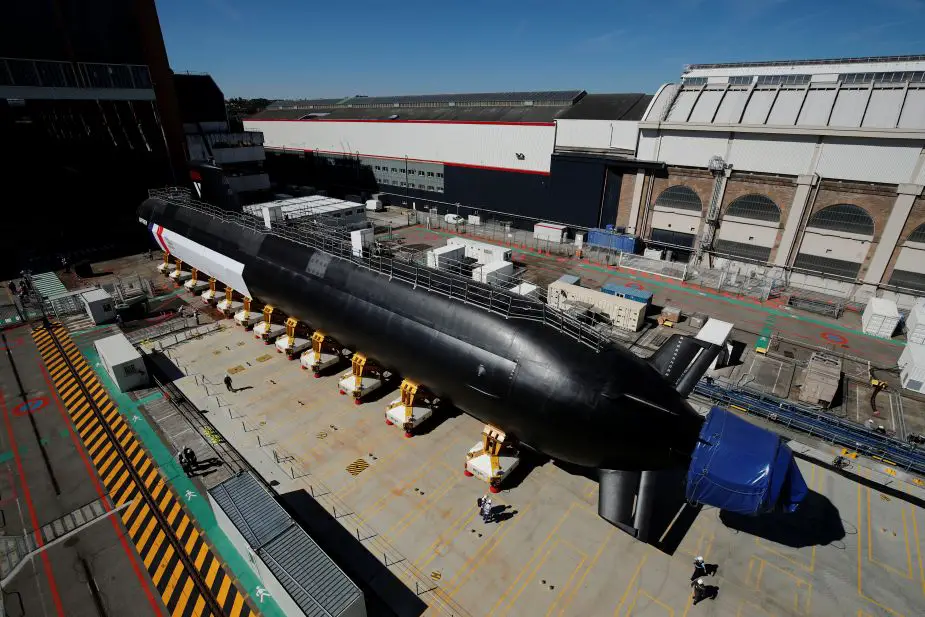In the presence of French President Emmanuel Macron, the first Barracuda-type nuclear propulsion attack submarine (SSN) will be presented this Friday, July 12, in her dry dock in Cherbourg.
 Transfer of the French Naval Group Suffren Barracuda Class submarine on the 5th of July, 2019. (Picture source: Naval Group)
Transfer of the French Naval Group Suffren Barracuda Class submarine on the 5th of July, 2019. (Picture source: Naval Group)
After more than ten years of work at the Naval Group shipyard, in the arsenal of Cherbourg, the latest nuclear-powered attack submarine will be officially unveiled. About 800,000 pieces make up this SSN. In a few weeks, it will be launched. This new submarine will be named "Suffren", the first in a series of six units of the program called "Barracuda" whose total cost is approaching 9 billion euro (instead of 7.9 originally planned).
Three other similar submarines will be delivered by 2025 (the "Duguay-Trouin", the "Tourville" and the "de-Grasse"), as their six predecessors, from the "Ruby-class", will be dismantled in Cherbourg, where they were launched from 1976. Two other ships will complete the new family by 2029: the "Casabianca" and the "Rubis" (for information, "Casabianca" was already the name of a submarine that made great achievements during the Second World War, under the command of Commander L'Herminier). These six SSNs are expected to remain in service until at least 2060.
The Barracuda-class (or Suffren-class) is a nuclear attack submarine (SSN), designed by the French shipbuilder Naval Group, formerly known as DCNS and DCN, for the French Navy, intended to replace the Rubis-class submarines. On 22 December 2006, the French government placed a €7.9 billion order for six Barracuda submarines with Naval Group and their nuclear powerplants with Areva-Technicatome. Construction began in 2007 and the first unit will be commissioned in 2019. The Barracuda class nuclear reactor incorporates several improvements over that of the preceding Rubis. Notably, it extends the time between refueling and complex overhauls (RCOHs) from 7 to 10 years, enabling higher at-sea availability.
Barracudas will use technology from the Triomphant class, including pump-jet propulsion. This class reportedly produces approximately 1/1,000 of the detectable noise of the Redoutable-class submarines (it will equal de noise made by shrimps), and they are ten times more sensitive in detecting other submarines.
With their new equipment, the Barracuda will now be able to launch naval cruise missiles with a range of about 1,000 km. The SSN will be fitted with torpedo-tube-launched cruise missiles MDCN SCALP Naval for long-range (well above 1,000 km, 620 mi) strikes against strategic ground targets. Their missions will include anti-surface and anti-submarine warfare, land attack, intelligence gathering, crisis management and special operations. In support of special operations missions, Barracudas may also accommodate up to 12 commandos whose equipment will be stored in a mobile pod; for this type of mission, they benefit from a deck hangar (somehow like the "Surcouf" of the 2nd World War), accessible from an airlock, which will allow the combat divers to rally a 3rd-generation underwater propulsor (a kind of pocket submarine), a capacity that until now only Americans and the British had.
Unlike SSBNs, nuclear attack submarines (SSNs) are not equipped with nuclear ballistic missiles. They are more stealthy. The concept of the nuclear submarine launcher (SSBN) is really to remain hidden, in silence, from the beginning until the end of her patrol. The only time she would betray her presence would be during a launch of nuclear missile(s). It's a submarine that serves only as a deterrent. It was decided not to risk compromising the mission of the SSBN by conventional missile launch.
Since 2013, the number of submarines in the world has increased by 6%. At the table of the UN Security Council, the five permanent members do have got ones (United States, Russia, China, United Kingdom, France). In addition to France, only the United States, Russia and China can manufacture nuclear-powered submarines. Australia has ordered twelve copies of the Barracuda. And traditional powers continue to equip themselves with more submarines. As a reference of China's growing naval power, in four years, the Chinese navy has built the equivalent of all the surface ships of the French navy.



